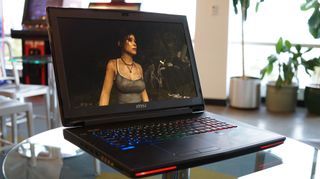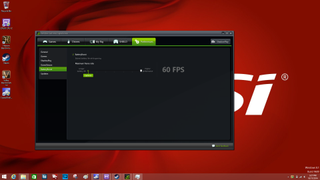GTX 980M benchmarked: testing Nvidia's mobile performance claims

When Nvidia announced the GTX 980M graphics card for gaming laptops, it made a bold claim: 75% of the performance of its desktop 980, which is currently the fastest single-GPU card on the market. The 680M, by comparison, delivered around 60% of the performance of the GTX 680 in 2012. That’s a huge growth for mobile GPU efficiency, if it’s true. In other words, the GTX 980M has a lot to live up to.
In our testing, the 980M delivered great performance at 1080p, but it didn’t come close to matching that 75% score of its desktop counterpart.
I tested the GTX 980M inside MSI’s GT72 Dominator gaming laptop, which runs on a 2.5GHz (3.5GHz turbo) Haswell i7-4710HQ processor, 32GB DDR3-800 RAM and a SATA SSD. It’s a $3000 configuration. If you need a refresher on the 980M itself, here are the specs:
| Specs | GTX 970M | GTX 980M |
| Base clock | 924 MHz | 1038 MHz |
| CUDA cores | 1280 | 1536 |
| Memory config | Up to 3GB 192-bit GDDR5 | Up to 4GB 256-bit GDDR5 |
| Memory speed | 2500 MHz | 2500 MHz |
Now for performance: I ran the GTX 980M through some popular benchmarks at the GT72’s default 1080p resolution, with all games set to ultra or very high settings. Because one of the big features Nvidia’s been talking up for the 900-series mobile GPUs is its Battery Boost technology, I ran each benchmark three different ways: on AC power, unplugged, and unplugged with Battery Boost disabled (and set to a framerate throttle of 60 fps). By default, Battery Boost limits the framerate to 30 fps, but I cranked that to the maximum of 60 fps to see if the laptop could manage that level of performance on battery.
Here are the average frames per second results of each benchmark at 1080p and ultra settings, typically with 4x MSAA and an ultra preset. In Tomb Raider, TressFX was enabled; in Metro: Last Light, tessellation was set to high.
The biggest gaming news, reviews and hardware deals
Keep up to date with the most important stories and the best deals, as picked by the PC Gamer team.
| Benchmark: unplugged, 1080p | GTX 980M: Battery Boost | GTX 980M: No Battery Boost |
| Unigine Valley | 29.8 | 29.6 |
| Batman: Arkham Origins | 51 | crashed multiple times |
| Tomb Raider | 33 | 34.3 |
| Thief | 34.4 | 34 |
| Metro: Last Light | 34 | 34 |
| Bioshock Infinite | 55.8 | 69.1 |
As you can see, each benchmark delivered playable framerates at 1080p and ultra settings, even unplugged. Playable, but often not great—realistically, most demanding games won’t be able to maintain a solid 60 fps at these settings unplugged. The GPU just can’t get enough juice off the battery alone to run at full capacity. These are obviously strenuous tests, and turning off a few settings, even playing at high with a few bells and whistles turned off, will deliver much more playable framerates.
If you can stomach gaming at 30 fps, though, Battery Boost will be able to keep games running smoothly. Disabling battery boost delivered slightly higher framerates in most games, but not enough to make a significant difference. It will take more testing to see how the MSI GT72’s battery life fares with battery boost enabled and disabled.

Though portability is the big selling point of a gaming laptop, typically, any serious gaming time spent with them will be spent plugged into an outlet. On-battery results don’t come anywhere close to the desktop 980’s performance, but that’s to be expected. Powered benchmarks are the true test.
At 1080p, the GTX 980M turned in great framerates plugged in, often getting above 60 frames per second. Because we did most of our desktop GTX 980 benchmarks at 2560x1600, I hooked the MSI GT72 up to a 30-inch monitor to test its performance against the full-size reference card, paired with a Haswell i7-3960X and 16GB DDR3. There it didn’t fare quite as well as Nvidia claimed.
| Benchmark: plugged in | GTX 980M @ 1080p | GTX 980M @ 1600p | GTX 980 @ 1600p |
| Unigine Valley | 50.3 | 27 | 44.5 |
| Batman: Arkham Origins | 87 | 44 | 75 |
| Tomb Raider | 55.2 | 35 | 57.6 |
| Thief | 53.8 | 32 | 50.5 |
| Metro: Last Light | 50 | 30.7 | 46 |
| Bioshock Infinite | 101 | 65.7 | 101.7 |
| Hitman Absolution | 48 | 30.8 | 41 |
It is impressive that the mobile 980M is able to push out enough pixels to run most of these games at ultra settings, 2560x1600, while keeping above 30 frames per second. At 1080p, lowering AA settings or turning down some post-processing could easily keep most games running at more than 60 frames per second, which makes this a hell of a mobile GPU.
But is the 980M actually 75% as fast as the GTX 980? If you do the math on the numbers above, the answer is no.
The performance discrepancy naturally varied between benchmarks, but all but Hitman Absolution fell below that 75% claim in my testing. Arkham Origins was 58% as fast. Thief was 63% as fast. Metro last light hit 67%. Hitman Absolution did actually live up to Nvidia’s claim and nailed 75% performance.
The numbers above don’t make a convincing claim for using Nvidia’s Dynamic Super Resolution downsampling on the 980M; the mobile graphics card is clearly best-suited to running games at 1080p. Unless you have to play every game on the highest possible settings (and if you do, why game on a laptop?) the 980M will be a great card for 1080p gaming. Testing at 1600p, I’d peg the 980M’s performance at approximately 65% of its desktop counterpart.
I’ll continue using the MSI GT72 laptop and do longer-term testing of the GTX 980; look for a full review of the laptop coming in the next few weeks.

Wes has been covering games and hardware for more than 10 years, first at tech sites like The Wirecutter and Tested before joining the PC Gamer team in 2014. Wes plays a little bit of everything, but he'll always jump at the chance to cover emulation and Japanese games.
When he's not obsessively optimizing and re-optimizing a tangle of conveyor belts in Satisfactory (it's really becoming a problem), he's probably playing a 20-year-old Final Fantasy or some opaque ASCII roguelike. With a focus on writing and editing features, he seeks out personal stories and in-depth histories from the corners of PC gaming and its niche communities. 50% pizza by volume (deep dish, to be specific).
Most Popular

